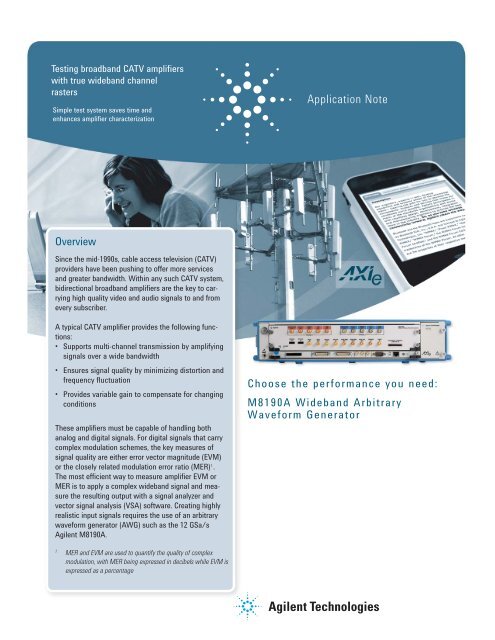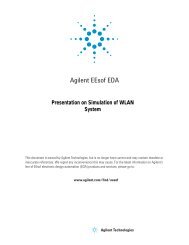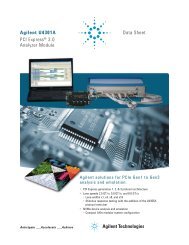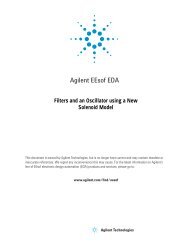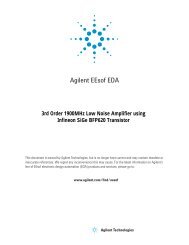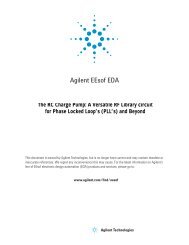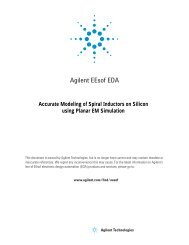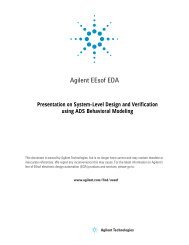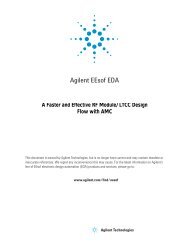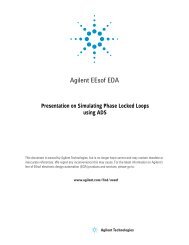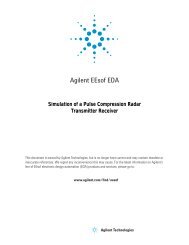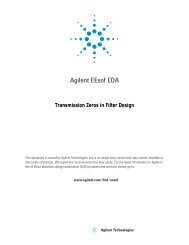Application Note - Agilent Technologies
Application Note - Agilent Technologies
Application Note - Agilent Technologies
Create successful ePaper yourself
Turn your PDF publications into a flip-book with our unique Google optimized e-Paper software.
Testing broadband CATV amplifiers<br />
with true wideband channel<br />
rasters<br />
Simple test system saves time and<br />
enhances amplifier characterization<br />
<strong>Application</strong> <strong>Note</strong><br />
Overview<br />
Since the mid-1990s, cable access television (CATV)<br />
providers have been pushing to offer more services<br />
and greater bandwidth. Within any such CATV system,<br />
bidirectional broadband amplifiers are the key to carrying<br />
high quality video and audio signals to and from<br />
every subscriber.<br />
A typical CATV amplifier provides the following functions:<br />
• Supports multi-channel transmission by amplifying<br />
signals over a wide bandwidth<br />
• Ensures signal quality by minimizing distortion and<br />
frequency fluctuation<br />
• Provides variable gain to compensate for changing<br />
conditions<br />
These amplifiers must be capable of handling both<br />
analog and digital signals. For digital signals that carry<br />
complex modulation schemes, the key measures of<br />
signal quality are either error vector magnitude (EVM)<br />
or the closely related modulation error ratio (MER) 1. .<br />
The most efficient way to measure amplifier EVM or<br />
MER is to apply a complex wideband signal and measure<br />
the resulting output with a signal analyzer and<br />
vector signal analysis (VSA) software. Creating highly<br />
realistic input signals requires the use of an arbitrary<br />
waveform generator (AWG) such as the 12 GSa/s<br />
<strong>Agilent</strong> M8190A.<br />
Choose the performance you need:<br />
M8190A Wideband Arbitrary<br />
Waveform Generator<br />
1.<br />
MER and EVM are used to quantify the quality of complex<br />
modulation, with MER being expressed in decibels while EVM is<br />
expressed as a percentage
Problem<br />
Without a wideband AWG, the process of estimating a wideband amplifier’s<br />
performance requires multiple steps. For example, the first step may be to perform<br />
a series of measurements at various signal levels using a vector network analyzer<br />
such as the <strong>Agilent</strong> ENA or PNA. The resulting S-parameter models will describe<br />
normal or linear operation while the X-parameter models will describe compressed<br />
or nonlinear operation.<br />
The next step is simulating the amplifier’s behavior when a wideband stimulus<br />
such as a CATV channel raster is applied. This requires that you transfer the<br />
S-parameter models to a software application such as SystemVue or ADS from<br />
<strong>Agilent</strong>. Within the software environment you can apply a wideband stimulus to<br />
the simulation and observe the estimated amplifier performance.<br />
This multi-step approach has two noteworthy shortcomings. First, it can be time<br />
consuming to make all the necessary narrowband measurements, capture the<br />
associated models and transfer those models to the simulator. Second, a series of<br />
narrowband measurements made at different operating points will lead to simulations<br />
that provide only an approximation of an amplifier’s actual operating behavior<br />
when handling wideband signals.<br />
Solution<br />
As an alternative to the issues described above, you can produce more accurate<br />
results—and check your simulations—by applying a simulated broadband stimulus<br />
directly to the amplifier and then measuring the analog and digital characteristics<br />
of its output signal. This can be done by creating a true wideband stimulus<br />
in software and downloading it to an AWG. An example system configuration, as<br />
created by members of <strong>Agilent</strong>’s application engineering organization, is shown in<br />
Figure 1.<br />
Figure 1. Basic block diagram of the test system.<br />
The key elements are a signal analyzer and an AWG—but not just any AWG will<br />
suffice. For example, some wideband units produce artifacts that add unwanted<br />
distortion to arbitrary signals. A source of greater fidelity is required for accurate,<br />
informative testing of broadband amplifiers.<br />
2
The <strong>Agilent</strong> M8190A AWG delivers high resolution and wide bandwidth simultaneously:<br />
14-bit resolution at 8 GSa/s and 12-bit resolution at 12 GSa/s. It also generates<br />
signals with spurious-free dynamic range (SFDR) of up to 80 dBc (typical) and<br />
harmonic distortion as low as –72 dBc (typical). With analog bandwidth of 5 GHz<br />
(via direct DAC output), the M8190A can handle CATV applications with direct RF<br />
output, no upconversion required.<br />
To test an example amplifier, the responsible application engineer created a simulation<br />
of a CATV signal based on an RF channel plan with 84 QAM64-modulated<br />
carriers. This was done with IQtools, an <strong>Agilent</strong>-provided piece of freeware for<br />
MATLAB, and the signal characteristics are shown in Figure 2. The simulated signal<br />
was an 800 MHz-wide channel plan with five active CATV channels followed<br />
by two inactive channels (Figure 3).<br />
Figure 2. Configuration screen from IQtools freeware showing setup for generating 84<br />
QAM64 signals.<br />
Figure 3. This zoomed measurement from an MXA signal analyzer shows the active and<br />
inactive channels.<br />
3
Results<br />
At this point, the key question was, “How good is this channel plan?” The question<br />
actually has two parts, namely the analog and digital performance of the<br />
signal. On the analog side, the key characteristics are flatness, signal-to-noise<br />
ratio (SNR), dynamic range, and SFDR. As shown in Figure 4, the generated<br />
signal is spurious-free from 10 MHz to 1 GHz, which is consistent with the –70<br />
dBc SFDR typical performance.<br />
Figure 4. The analog characteristics of the full channel plan show no spurs<br />
between 10 MHz and 1 GHz.<br />
As noted earlier, EVM and MER are key indicators of digital performance. These<br />
can be measured and viewed with an MXA equipped with either the N6152A<br />
digital cable TV app, which provides DVB-C demodulation and analysis, or the<br />
<strong>Agilent</strong> 89600 VSA software with option AYA, vector modulation analysis. As<br />
shown in Figure 5, a single channel within the 84 QAM64 signals has an EVM<br />
better than 0.5% and an MER of 43 dB.<br />
Figure 5. The digital characteristics of one channel within the 84-channel QAM64 signal<br />
show excellent results for EVM, MER and more.
Conclusion<br />
Specific to CATV applications, the two-instrument system configuration reduces<br />
complexity, saves time and provides thorough characterization of wideband<br />
amplifiers. With its high resolution and wide bandwidth, the M8190A AWG is<br />
capable of producing virtually any channel plan for the testing of CATV devices.<br />
Taking a more general view, the example system has the flexibility to address a<br />
variety of wideband applications at RF and, with upconversion, microwave applications.<br />
What’s more, ultra-wideband (UWB) applications can be addressed by<br />
adding a high-performance oscilloscope such as the <strong>Agilent</strong> 90000 X-Series,<br />
which can run the 89600 VSA software.<br />
Related literature<br />
Type of Document Title Publication Number<br />
Data sheet M8190A 12 GSa/s arbitrary 5990-7516EN<br />
waveform generator<br />
Brochure N9020A MXA signal analyzer 5989-5047EN<br />
Brochure X-Series signal analyzers 5990-7998EN<br />
Brochure<br />
89600 vector signal analysis<br />
software<br />
5990-6553EN<br />
MATLAB information: Please visit www.mathworks.com/products/matlab and<br />
www.agilent.com/find/matlab<br />
5
www.axiestandard.org<br />
<strong>Agilent</strong> Channel Partners<br />
www.agilent.com/find/channelpartners<br />
<strong>Agilent</strong> Advantage Services is committed to your<br />
success throughout your equipment’s lifetime.<br />
www.agilent.com/find/advantageservices<br />
<strong>Agilent</strong> Email Updates<br />
www.agilent.com/find/emailupdates<br />
Bluetooth and the Bluetooth logos are trademarks owned by Bluetooth<br />
SIG, Inc., U.S.A. and licensed to <strong>Agilent</strong> <strong>Technologies</strong>, Inc.<br />
www.agilent.com<br />
www.agilent.com/find/M8190<br />
For more information on <strong>Agilent</strong> <strong>Technologies</strong>’ products,<br />
applications or services, please contact your local <strong>Agilent</strong> office.<br />
The complete list is available at:<br />
www.agilent.com/find/contactus<br />
Americas<br />
Canada (877) 894 4414<br />
Brazil (11) 4197 3600<br />
Mexico 01800 5064 800<br />
United States (800) 829 4444<br />
Asia Pacific<br />
Australia 1 800 629 485<br />
China 800 810 0189<br />
Hong Kong 800 938 693<br />
India 1 800 112 929<br />
Japan 0120 (421) 345<br />
Korea 080 769 0800<br />
Malaysia 1 800 888 848<br />
Singapore 1 800 375 8100<br />
Taiwan 0800 047 866<br />
Other AP Countries (65) 375 8100<br />
Europe & Middle East<br />
Belgium 32 (0) 2 404 93 40<br />
Denmark 45 45 80 12 15<br />
Finland 358 (0) 10 855 2100<br />
France 0825 010 700*<br />
*0.125 €/minute<br />
Germany 49 (0) 7031 464 6333<br />
Ireland 1890 924 204<br />
Israel 972-3-9288-504/544<br />
Italy 39 02 92 60 8484<br />
Netherlands 31 (0) 20 547 2111<br />
Spain 34 (91) 631 3300<br />
Sweden 0200-88 22 55<br />
United Kingdom 44 (0) 118 927 6201<br />
For other unlisted countries:<br />
www.agilent.com/find/contactus<br />
Revised: January 6, 2012<br />
Product specifications and descriptions<br />
in this document subject to change without notice.<br />
© <strong>Agilent</strong> <strong>Technologies</strong>, Inc. 2012<br />
Published in USA, January 31, 2012<br />
5990-9871EN


